Fear of fitting rooms: Tech to find your inner shopaholic
- Published
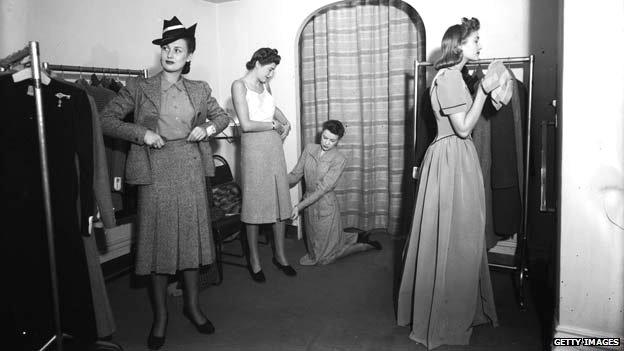
Suits you: The modern fitting room experience is a far cry from the elegant days of the Army and Navy stores
The fluorescent lights are flickering, the mirror is clearly (clearly!) warped, you're dripping with sweat.
Standing there crammed into a pair of jeans two sizes too small, you become grimly resigned to the fact that you look more like an overweight haddock than the shapely denim god of your imagination.
Congratulations. You're shopping on the High Street in the 21st Century. It's an experience most of us either love or hate.
And it's this fear of fitting rooms that's pushing some of us online, which makes this the stuff of nightmares not only for consumers, but for the businesses they're fleeing.
Remote control shopper
Nadia Shouraboura loves clothing. But she doesn't enjoy the endurance test finding the right pair of jeans can be.
"When I would go shopping in a traditional store, I always would be disappointed with the experience, lugging clothes to a fitting room, standing in the fitting room naked, and screaming through the door, asking an associate to bring me something," she says.
"And I hate destroying piles of clothes... I feel very uncomfortable playing with the pile and spreading it apart, because I know somebody needs to come and clean it.
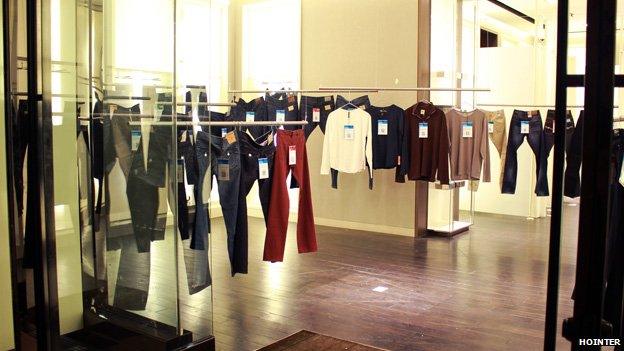
Line up: The clothes at Hointer are hung, one item for each line, on rails for customers to browse through
"So all those things I thought we can drastically improve with technology."
As the former head of supply chain and fulfilment technologies for online retail giant Amazon, Dr Shouraboura wasn't short on ideas.
The result was Hointer, a concept store set up in Seattle, initially geared towards men.
Clothes are displayed on minimalist rails which let shoppers have a good look.
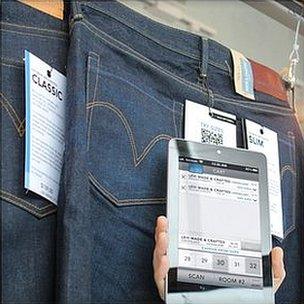
Shoppers select items by either scanning a QR code or by tapping with an NFC enabled device
If you want to try something on, you simply tap the item with your smartphone if it has NFC (near field communication), or alternatively scan a QR code. You are automatically allocated a fitting room, and can continue shopping.
When you finish, you head straight to your own room where the clothes are waiting for you, having been delivered by robotic pickers working in the background.
Need a different size?
"If you tap it with your phone, an item will whoosh in, like there will be a sound - whoosh," says Dr Shouraboura. "And the item will appear literally in front of you in under 30 seconds."
When you're ready to leave, pop the clothes in the chute. And if you decide to buy you simply swipe your credit card at an automatic terminal.
Prices are dynamic, so vary throughout the day to constantly undercut internet prices - and stop shoppers browsing in store and then buying online.
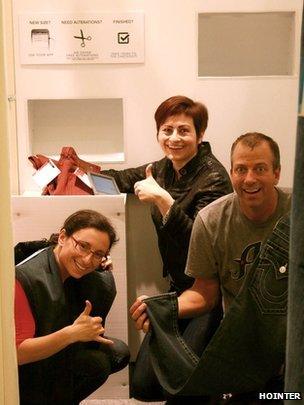
Nadia Shouraboura (centre) and some of her team in one of the automated fitting rooms
This is possible because overheads are kept low, says Dr Shouraboura. Less space means lower rent, the wage bill is lower as automation means fewer staff - and on the shop floor there's no need to re-hang or fold clothes, price items or man the till.
The technology behind this involves a showroom floor and robotic micro-warehouse, controlled by a central system that the smartphone and tablet apps communicate with.
"It is very fast. It is extremely compact. So it is like a can of sardines which can retrieve any item for the customer in a very quick way."
Dr Shouraboura believes innovation like this can go a long way to helping bricks and mortar retailers survive the online onslaught.
"Right now online experience is great, but I think the in-store experience can be even better because you can try items on and you can touch and you can feel," she says.
"I think the in-store experience can also be cheaper because you don't incur any transportation costs you could have in your returns."
Top to toe
Now you just need to find the right fit to make those lumps and bumps turn into curves in the right places.
But a size 10 in one shop can easily be a size 14 in another. Especially when deep down we all know we're two sizes smaller than the shops say we are.
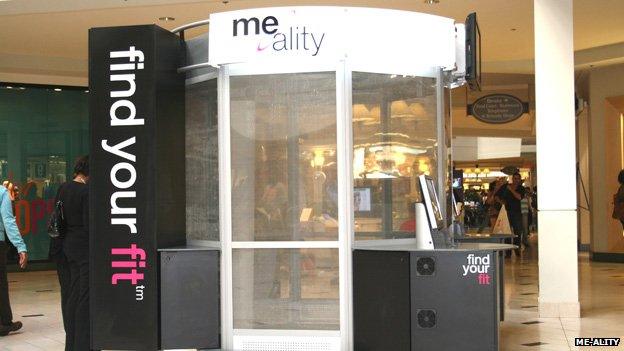
The Me-ality: If airport body scanners also recommended the perfect pair of jeans, there might be fewer complaints
A Canadian invention found in over 20 malls across the United States is trying to convince women that it is not the size on the tag that matters - it's the fit.
The Me-ality is a booth that scans you fully-clothed, from top to toe, and produces a profile of your body that is stored in a personal online account.
It then recommends items of clothing that will fit you best.

Inside the booth, shoppers must stand still with their arms in a triangle shape for around 20 seconds
The booth works using a system called millimetre wave technology. After entering the Me-ality, the customer stands still with their arms pointing towards their hips.
A wand circles twice, each rotation taking around 10 seconds. Radio waves are released which bounce off the moisture in the shopper's skin.
"That will give us 200,000 points of reference on their body," says Me-ality's Kathleen Funke.
"Our software cross-references that information with the specific measurements that we take from clothing in our system, and prints out a report."
The system works with nearly 200 different brands. US department store Bloomingdale's is using it to help customers find that often-elusive perfect pair of jeans.
"There is a big shift in consumer behaviour in the retail world, and it is being driven by technology," says Ms Funke.
"Retailers' success hinges on being able to quickly adapt to, and integrate those new technologies. They are at risk of marginalisation at the hands of online retailers."
Fitting in
But what if the very thought of heading into the fitting room leaves you rocking in a darkened corner?
Fits.me provides a virtual fitting room service that lets shoppers see how a garment fits their particular shape without ever having to disrobe.
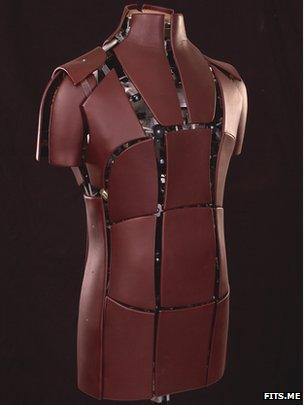
The robots are made up of an intricate network of panels that simulate muscle and fat
"Fitting rooms generally speaking on the High Street aren't the best experience in the world," says Fits.me's Peter Rankin.
"The lighting is not great, most of them quite smelly, people feel they are being looked at as a potential shoplifter, so people generally don't really enjoy the experience."
"Larger people generally speaking are very uncomfortable in a public fitting room, even with private cubicles. So this could be seen as much more private."
Morphing
Primarily aimed at online retailers, the service is also available in-store on tablets, or as a virtual shop assistant using a smartphone. The company has also just signed a deal with television shopping channel QVC to use the technology on screen.
Sophisticated robot mannequins made up of panels that simulate muscles are used. When the robot is loaded with measurements it then morphs into that shape.
The mannequins are connected to a laptop and camera, and are dressed in key items from a retailer's stock to demonstrate fit across their lines.
Each size is put through every possible permutation in size and dimension and photographed at speed to build up a database of different possibilities.
The images of the garment are then cut out and fitted to a human avatar using a semi-automated process.
So a shopper looking for a shirt enters a set of measurements on the website or app, and is presented with a human avatar displaying their particular body shape. They can then click through the different sizes available until they find the perfect fit.
"We cover about 97% to 98.5% of body sizes and shapes," says Mr Rankin.
"You can always find somebody that has got a particularly long body, or someone who has got completely disproportionate length of arms, and they need to consider that in the context."
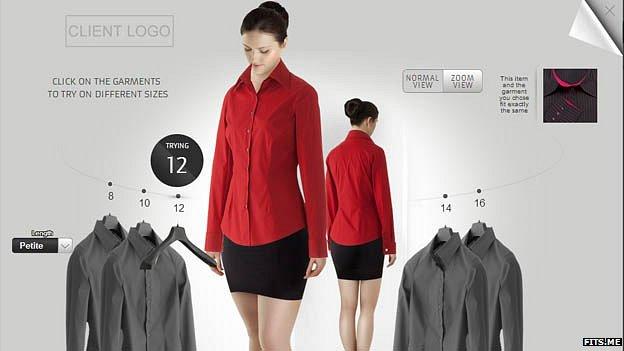
Virtually there: Once you have entered your vital statistics, you can watch your avatar trying on different sizes
The company is working with global names like Adidas, Boden, and LK Bennett, with Superdry and Nicole Farhi among those in the pipeline.
The next stage according to Mr Rankin is to install robots where there are already photographic studios to speed up the process.
Fitting the future
In Seattle, Nadia Shouraboura is busy.
Hointer recently started stocking womenswear.
"Every woman who came to the store shopping with her husband came to me and gave me a lot of grief, telling me 'I want to shop that way, what are you doing, men don't care for shopping!'," she says.
The company is expanding, with new stores as well as plans to offer delivery for out of stock items.
Dr Shouraboura says Hointer sees itself as a technology company rather than a retailer - and they are already working with other US retailers to install the technology.
The idea of avoiding that overweight haddock moment is certainly beguiling.
And until technology can either morph your own body into a perfect size 8 - or 3D print bespoke garments in the privacy of your own home - technology like this, external may be enough to keep customers coming back to the High Street.